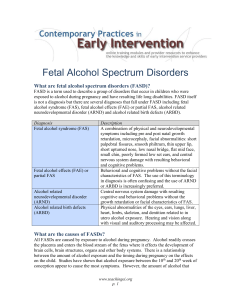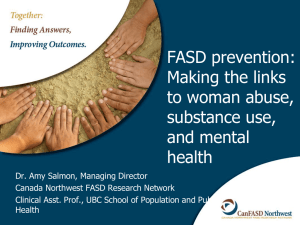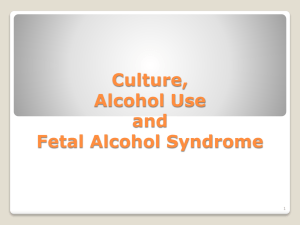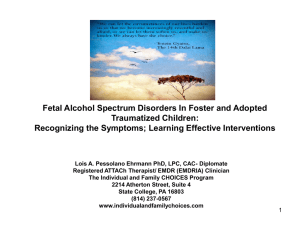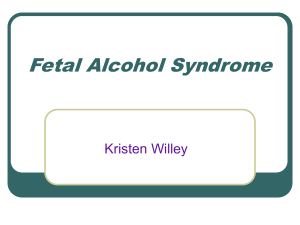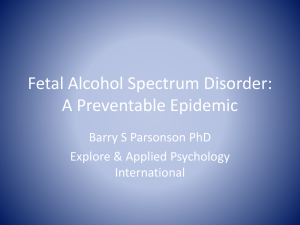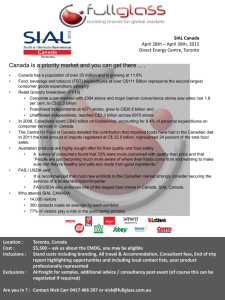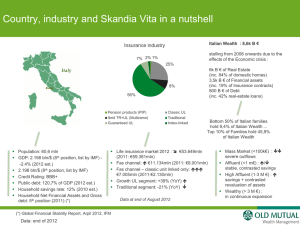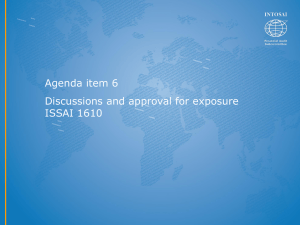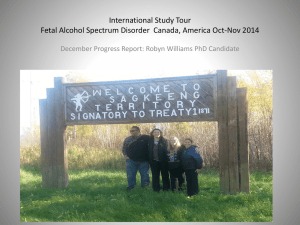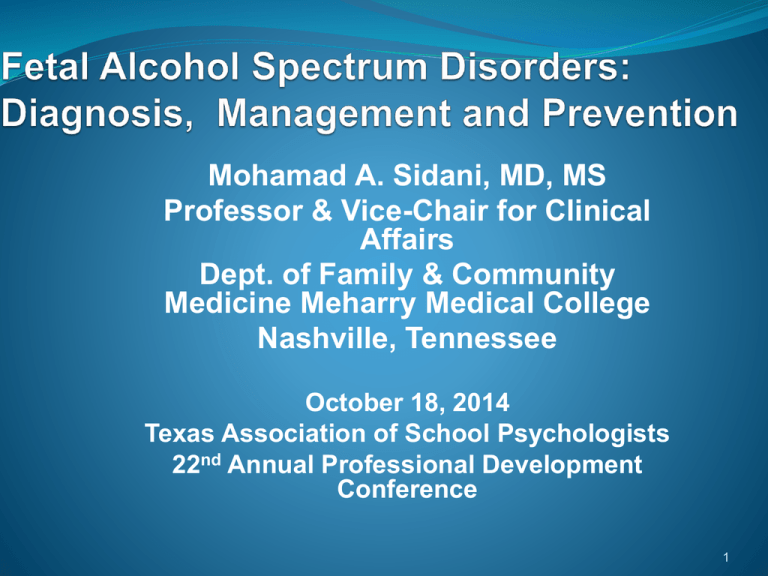
Mohamad A. Sidani, MD, MS
Professor & Vice-Chair for Clinical
Affairs
Dept. of Family & Community
Medicine Meharry Medical College
Nashville, Tennessee
October 18, 2014
Texas Association of School Psychologists
22nd Annual Professional Development
Conference
1
Presenter Disclosures
Mohamad Sidani, MD, MS
The following personal financial relationships with
commercial interests relevant to this presentation
existed during the past 12 months:
“No relationships to disclose”
2
Goals and Objectives
1. Review the diagnostic criteria for FAS and FASDs
2. Review the prevalence of FAS and FASD
3. Review some neurobehavioral problems
associated with FASDs
4. Review intervention & treatment options of
children with FAS/FASD
5. Review FASDs prevention/alcohol screening and
brief intervention.
3
Barriers We Face as
Providers
Diagnosis and Care of Children with FASDs
Lack of training
Uncertain about how to intervene if problem
is found
Fear of offending mother
Belief that the harm is already done
Weisner C, Matzger H. Alcohol Clin Exp Res. 2003 Jul;27(7):1132-41;
Nevin AC et al. BMC Fam Pract. 2002;3:2.
4
Zoorob R, Aliyu MH, Hayes C. Alcohol. 2010 Jun;44(4):379-85.
Criteria for Diagnosing
Fetal Alcohol Syndrome (FAS)
With or w/o confirmed fetal exposure to
alcohol, diagnosis requires documentation of:
1.All three dysmorphic facial features (smooth
philtrum, thin vermillion border, small palpebral
fissures)
2.Growth deficits
3.CNS abnormality
• Bertrand J, Floyd RL, Weber MK. Guidelines for Identifying and Referring Persons with Fetal Alcohol
syndrome. Morbidity and Mortality Weekly Review. October 28, 2005/54;1-10
• www.cdc.gov
5
# 1. Facial Abnormalities Of
FAS
1. Smooth philtrum
2. Thin vermillion
3. Small palpebral fissures
Photo courtesy of Teresa Kellerman
6
Lip-Philtrum Guide
Developed by University of
Washington FAS Diagnostic
& Prevention Network
Guide 1 – Caucasians
Guide 2 – African Americans
Back side provides face &
height-weight tables from
the FASD Diagnostic Guide
(2004)
Order from:
http://depts.washington.edu/
fasdpn/htmls/orderforms.htm
http://fasdcenter.samhsa.gov/educationTraining/courses/CapCurriculum/competency2/facial2.cfm
7
Lip-Philtrum Guide
The Lip-Philtrum Guide reflects the full range of lip
thickness and philtrum depth.
The Rank 3 : the mean (or 50th percentile).
The Rank 5 : (< 2.5th percentile) the typical
expression of the smooth philtrum and thin upper lip
seen in individuals with FAS
The Rank 1 : (> 97.5th percentile).. is an example of
an individual with a very deep philtrum and full upper
lip
8
Measuring the Palpebral Fissures
Astley, et al. Magnetic Resonance Imaging Outcomes From a Comprehensive Magnetic Resonance Study of
Children With Fetal Alcohol Spectrum Disorders. Alcoholism: Clinical and Experimental Research, Oct 9
2009.
PFL Measurement
Sliding Digital Calipers: The gold standard not
safe to measure a person’s eye with a sliding
digital caliper.
Hand-held Ruler: used the most; inaccurate
Software: FAS Facial Photographic Analysis
Software measures PFL from a photograph.
http://depts.washington.edu/fasdpn/
10
http://depts.washington.edu/fasdpn/pdfs/pfl-software-accuracy.pdf
Sliding Digital Calipers
11
http://depts.washington.edu/fasdpn/pdfs/pfl-software-accuracy.pdf
Hand-held Ruler
12
http://depts.washington.edu/fasdpn/pdfs/pfl-software-accuracy.pdf
FAS Facial Photographic Analysis Software
13
Diagnostic Guide for Fetal Alcohol Syndrome and Related Conditions The 4-Digit Diagnostic Code Second
Edition FAS Diagnostic and Prevention Network University of Washington.1999
14
Dysmorphic Facial Features FAS
Clinical feature
Shortened palpebral
fissures
Criteria
≤10th percentile for
age and racial norms
Smooth philtrum
Score of 4 or 5 on LipPhiltrum Guide
Thin vermilion border
of upper lip
Score of 4 or 5 on LipPhiltrum Guide
15
Smooth Philtrum
Occurs also in:
Cornelia de Lange syndrome
Floating-Harbor syndrome
Geleophysic dysplasia
Opitz syndrome
Toluene embryopathy
Fetal Alcohol Syndrome. Guidelines for Referral and Diagnosis. CDC. May 2005
16
Thin Vermillion Border
Occurs also in:
Miller-Dieker (Lissencephaly) syndrome
Fetal Valproate syndrome
Geleophysic dysplasia
Cornelia de Lange syndrome
Toluene embryopathy
Fetal Alcohol Syndrome. Guidelines for Referral and Diagnosis. CDC. May 2005
17
Short palpebral Fissure
Occurs also in:
Campomelic dysplasia
•
•
DiGeorge sequence
•
Dubowitz syndrome
Duplication 10q sequence •
Duplication 15q sequence •
•
FG syndrome
Oculodentodigital syndrome
Opitz syndrome
Trisomy 18 syndrome
Williams syndrome
Velocardiofacial syndrome
Toluene embryopathy
Maternal phenylketonuria
(PKU)
18
Photo courtesy of the University of Louisville Fetal Alcohol Spectrum Disorders
(FASD) Clinic - Weisskopf Child Evaluation Center, and the
FASD Southeast Regional Training Center at Meharry Medical College
Department of Family and Community Medicine: FASDsoutheast.org
Any use of this photo requires written permission from the University of Louisville
FASD Clinic - Weisskopf Child Evaluation Center and the proper
acknowledgement as written in this caption.
19
Photo courtesy of the University of Louisville Fetal Alcohol Spectrum Disorders (FASD) Clinic - Weisskopf
Child Evaluation Center, and the FASD Southeast Regional Training Center at Meharry Medical College
Department of Family and Community Medicine: FASDsoutheast.org Any use of this photo requires written
permission from the University of Louisville FASD Clinic - Weisskopf Child Evaluation Center and the proper
acknowledgement as written in this caption.
20
Photo of a 6-year old child with FAS.
Courtesy of the Great Lakes FASD
Regional Training Center.
21
Photo of a 13-year old child with FAS. Courtesy of the Great lakes Regional
Training Center.
22
23
Characteristic features of an ear of a child with fetal
alcohol spectrum disorders. Note the underdeveloped
upper part of the ear parallel to the ear crease below
(“railroad track” appearance).
Am Fam
Physician. 2005 Jul 15;7
2(2):279-285
Characteristic features
of a hand of a child
with fetal alcohol
spectrum disorders.
Note the curved fifth
finger (clinodactyly)
and the upper palmar
crease that widens and
ends between the
second and third
fingers (“hockey stick”
crease).
Am Fam Physician. 2005 Jul 15;72(2):279285
#2. Growth Deficits in FAS
Timing
Prenatal or Postnatal
At any one point
Degree
≤ 10th percentile adjusted for age,
sex, gestational age, and race or
ethnicity
Height or Weight
26
UCLA
Courtesy of the UCLA RTC
27
#3. CNS Abnormalities of
FAS
I. Structural
OR
I. Neurological
OR
I. Functional Abnormality
Bertrand J, Floyd RL, Weber MK. Guidelines for Identifying and Referring Persons with Fetal
Alcohol syndrome. Morbidity and Mortality Weekly Review. October 28, 2005/54;1-10
28
#3. CNS Abnormalities of FAS
I.
Structural
−
−
Head circumference ≤ 10% (adjusted for age,
sex) (or ≤3rd percentile for children whose height
and weight are ≤10th percentile)
OR
Clinically significant brain abnormalities observed
through imaging (reduction in size or change in
shape of corpus callosum, cerebellum,
hippocampus, or basal ganglia)
Bertrand J, Floyd RL, Weber MK. Guidelines for Identifying and Referring Persons with Fetal
Alcohol syndrome. Morbidity and Mortality Weekly Review. October 28, 2005/54;1-10
29
#3. CNS Abnormalities of FAS
II. Neurological
Neurological problems not due to a
postnatal insult or fever
OR
other soft neurological signs outside
normal limits
30
#3. CNS Abnormalities of FAS
III. Functional Abnormality: Performance
substantially below that expected for an
individual’s age, schooling, or circumstances,
as evidenced by:
1. Global cognitive or intellectual deficits (or significant
developmental delay in younger children) with
performance below the 3rd percentile (2 standard
deviations below the mean for standardized testing)
OR
31
#3. CNS Abnormalities of
FAS
2.
Functional deficits (<16th percentile) in at least 3
domains:
a.
cognitive or developmental deficits or discrepancies
b.
executive functioning deficits
motor functioning delays
problems with attention or hyperactivity
social skills
other, such as sensory problems, pragmatic
language problems, memory deficits, etc.
c.
d.
e.
f.
32
Age Effect
Cognitive deficits and behavioral disorder typically
become more apparent in school-aged children with
FASD and usually persist into adolescence and
adulthood
Facial findings among the subset with FAS may
become less characteristic with age.
33
Incidence of FAS
Comparable with or higher than rates for other
common developmental disabilities (Down’s
syndrome, spina bifida)
0.2 to 1.5 cases of FAS per 1,000 live births in the
US
Approximately 4 million infants are born in the US
per year
An estimated 1,000--6,000 are born with Fetal
Alcohol Syndrome
CDC. MMWR Morb Mortal Wkly Rep 2002;51:433-435.
34
Economic Burden
FAS alone costs the United States > $ 4
billion annually in direct and indirect costs.
Lifetime health cost for an individual with
FAS was estimated at is $ 2.0 million in
2002.
www.cdc.gov
35
What are FASDs?
“Fetal Alcohol Spectrum Disorder” is
NOT a diagnostic category, but rather
an umbrella term describing a range of
effects that can occur in a person whose
mother drank alcohol during pregnancy”
Bertrand J, Floyd RL, Weber MK. MMWR. October 28, 2005 / 54;1-10.
36
FASD prevalence
We do not know exactly how many people have an
FASD.
Scientists believe that there are at least three times
as many cases of FASDs as FAS
37
FASDs Distribution
FASDs affect every segment of the
population.
All racial groups and economic classes are
affected by FASDs.
Social, economic and environmental
factors all contribute to the higher rates of
FASDs in some populations.
Fetal Alcohol Spectrum Disorders handbook. Center for Disabilities. Sanford School of Medicine of
The University of South Dakota. www.usd.edu/cd
38
FASDs Distribution
Some groups have been found to have
higher rates of FAS/FASDs:
Disadvantaged groups, some American
Indian/Alaska Native groups, and other
minorities.
Children in foster care.
Youth in juvenile justice system.
CDC Diagnostic Guidelines, 2004
39
FASDs Diagnostic Criteria
The term FASDs is not meant for use as a
clinical diagnosis.
Guidelines were developed for FAS only.
CDC and its partners are working to put
together diagnostic criteria for other
FASDs, such as ARND. Clinical and
scientific research on these conditions is
going on now.
www.CDC.gov
40
41
Types of FASDs: FAS
1. Fetal Alcohol Syndrome (FAS): The
severe end of the FASD spectrum..
www.CDC.gov
42
Types of FASDs: ARND
2. Alcohol-Related Neurodevelopmental
Disorder (ARND):
•
•
Intellectual disabilities and problems with
behavior and learning.
poor performance at school, difficulties
with math, memory, attention, judgment,
and poor impulse control.
www.CDC.gov
43
Types of FASDs: ARBD
3. Alcohol-Related Birth Defects (ARBD):
People with ARBD might have problems
with the heart, kidneys, or bones or with
hearing. They might have a mix of these.
www.CDC.gov
44
Partial FAS (IOM, Hoyme
Criteria)
Partial FAS With or without Confirmed
Maternal Alcohol Exposure:
1.Documentation of 2 of the three dysmorphic
facial features (smooth philtrum, thin
vermillion border, small palpebral fissures)
2.Documentation of either growth deficits or
CNS abnormality
Hoyme, Eugene. Pediatrics 2005;115;39
45
ARND (IOM, Hoyme Criteria)
ARND (diagnosis requires 1 and 2):
1. Confirmed maternal alcohol exposure
2. CNS - at least one of:
Structural brain abnormalities
Head circumference ≤10th percentile
Evidence of a complex pattern of behavioral or
cognitive abnormalities inconsistent with
developmental level that cannot be explained by
genetic predisposition, family background, or
environment alone.
Hoyme, Eugene. Pediatrics 2005;115;39
46
ARBD (IOM, Hoyme Criteria)
All three Criteria
1. Confirmed maternal alcohol exposure.
2. Two or more of FAS facial features:
3. Congenital structural defects > 1category (≥2
required if only minor abnormalities):
a. Cardiac anomalies: ASD, VSD, AGV,
Conotruncal defects
b. Skeletal anomalies :Radioulnar synostosis,
Vertebral segmentation defects, Large joint
contractures, Scoliosis.
Hoyme, Eugene. Pediatrics 2005;115;39
47
ARBD (IOM, Hoyme Criteria)
Renal anomalies: Aplastic, dysplastic, or hypoplastic
kidneys; Ureteral duplication; Horseshoe kidneys.
d. Ocular anomalies:Strabismus, Ptosis, Retinal
vascular anomalies, Optic nerve hypoplasia.
e. Ears: Conductive or Sensorineural hearing loss.
f. Minor abnormalities: Hypoplastic nails, Short fifth
fingers, Camptodactyly, Clinodactyly of fifth fingers,
Pectus carinatum or excavatum, Hockey-stick
palmar creases, Refractive errors, Railroad-track
ears.
c.
Hoyme, Eugene. Pediatrics 2005;115;39
48
Characteristic features
of a hand of a child
with fetal alcohol
spectrum disorders.
Note the curved fifth
finger (clinodactyly)
and the upper palmar
crease that widens and
ends between the
second and third
fingers (“hockey stick”
crease).
Am Fam Physician. 2005 Jul 15;72(2):279285
49
The 4-Digit Diagnostic Code
The four digits reflect the magnitude of
expression of four key diagnostic features of FAS
in the following order:
growth deficiency,
2. the FAS facial phenotype,
3. brain dysfunction
4. gestational alcohol exposure
1.
The magnitude of expression of each feature is
ranked independently on a 4-point Likert scale.
Diagnostic Guide for Fetal Alcohol Syndrome and Related Conditions The 4-Digit Diagnostic Code Second
Edition FAS Diagnostic and Prevention Network University of Washington.1999
50
Hereditary Effect
FASD is not inherited
There seems to be a genetic predisposition
to problem drinking.
Twin studies document similar outcomes in
identical twins and different outcomes in
non-identical twins.
Pediatrics 2005;115:39-47.
51
52
Fetal Alcohol Exposure Effects
on Neuro-behavior
FASDs are the leading cause of mental
retardation
FASDs are the only preventable causes of
mental retardation.
Not all people with FASDs have mental
retardation. In fact the IQ range from 29-140
www.cdc.gov/ncbddd/fasd/videos/Iyal/long/Iyal_long.html
53
Psychiatric/Behavioral
Verbal Learning: People with FASDs have problems
with verbal learning, different than in Down
syndrome.
FASDs affect people's ability to initially encode in
memory, -but once encoded, recall is as good as
for anyone else.
Down syndrome, both storage and recall are
impaired.
Visual-Spatial Learning: difficulty with learning
spacial relationships between objects and with
mathematics.
54
Psychiatric/Behavioral
Attention: (hallmark of prenatal alcohol exposure).
So common amongst people with FASDs that they are
often misdiagnosed with attention deficit disorders.
People with classic attention deficit disorder tend to
have difficulty focusing and maintaining attention.
People with FASDs have fewer problems with focusing
and maintaining attention, but more trouble shifting
attention from one task to another (what researchers
call "set shifting").
55
Psychiatric/Behavioral
Reaction time: One of the key effects of FASDs:
Slow reaction time
Reduced brain processing speed.
Both of these affect overall intelligence by limiting
the brain's capacity to take in information rapidly,
particularly in a setting like an ordinary classroom.
56
Psychiatric/Behavioral
Executive Function: One of its cruelest
effects:
The ability to plan for the future and to
change behavior in response to the
effects of previous actions.
Are often incapable of learning from
experience and may repeat behaviors
over and over despite negative results.
57
Psychiatric/Behavioral
Executive Function (Cont’d):
Cannot put together a sequence of actions
in order to achieve a goal-for example,
taking the steps necessary to do homework
adequately or to pay a bill on time.
Get "stuck" on certain things and cannot
keep the whole process in mind while
carrying out the steps needed to complete
it.
58
Psychiatric/Behavioral
Impulsive:
Often impulsive and may react without
thinking.
Often diagnosed with conduct disorder and/or
oppositional defiant disorder and may have
frequent run-ins with law enforcement as they
appear to be willfully disobeying authorities
and actively seeking repeat punishment.
FASDs also appear to make people more likely
to lie.
59
Psychiatric/Behavioral
Socialization:
Difficulties recognizing social cues. Often "can't take a
hint," or recognize non-verbal suggestions.
Intrusiveness: excessive body contact
They may be overly demanding of attention and may
lack empathy towards others. Lack of stranger anxiety
Eager-to-please and easily lead. They may be preyed
upon and pushed to commit crimes.
Tendency towards sexual promiscuity.
60
Kindergarten – Sixth Grade
Easily influenced by others
Memory loss and retrieval problems. Needs things
repeated multiple times and still may not retain
information.
Lying, stealing, or disobedient
Problems separating fantasy from reality, having a
different perception of reality
Temper tantrums
Delayed physical, academic, and/or social
development
Silence, retreating from situations
Inappropriate social behavior
61
Beyond Early Childhood
Difficulties Socializing
Maintaining Friendships
Depression and Anxiety
Inappropriate Sexuality
62
Middle School/Junior High
Self-centered (act younger than stated age)
Criminal activity
Poor reasoning skills
Cognitive problems from previous section do not
improve (memory, recall, reality, etc.)
Poor motivation, low self-esteem, depression
Sexually active, drug or alcohol use
Lacks time management skills, no concept of time
63
Actual Age: 18
Expressive Language ----------------------------------- 20
Comprehension ------- 6
Money, time concepts ------- 8
Emotional maturity ---- 6
Physical maturity ---------------------------------- 18
Reading Ability ------------------------------- 16
Social Skills ---------------- 7
Living Skills --------------------- 11
Vineland Adaptive Behavior Scales
64
…. Even Beyond Early Childhood
Disrupted Schooling
43% of teens with FASDs are at high risk of having
school interrupted by suspension, expulsion, or
from dropping out
Conduct Problems
Antisocial Behaviors
Inability to follow rules, lying, and stealing
GOAL
Independent Living
65
Secondary Disabilities
Mental health problems-more than 90%
Alcohol and other drug problems-35%
Disrupted school experiences->60%
Juvenile justice 60%
Juvenile confinement 40%
Streissguth, A. (1997). Fetal Alcohol Syndrome: A Guide for Families and Communities.
Baltimore: Brookes Publishing. ISBN 1-55766-283-5
66
Co-occurring conditions in FASD
Attention-Deficit/Hyperactivity Disorder (ADHD)
Oppositional Defiant Disorder (ODD)
Conduct Disorder (CD)
Reactive Attachment Disorder (RAD)
Sleep Disorders
Schizophrenia
Depression
Bi-polar disorder
Substance use disorders
Post-Traumatic Stress Disorder (PTSD)
67
Protective Factors
Living in a stable and nurturing home for over 72% of life
Being diagnosed with FAS before age six
Never having experienced violence
Remaining in each living situation for at least 2.8 years
Experiencing a "good quality home" from age 8 to 12 years old
Having been found eligible for developmental disability (DD)
services
Having basic needs met for at least 13% of life
Having a diagnosis of FAS (rather than another FASD
condition)
Streissguth, A. (1997). Fetal Alcohol Syndrome: A Guide for Families and Communities.
Baltimore: Brookes Publishing. ISBN 1-55766-283-5.
68
Work UP
Gather historical information about prenatal
alcohol exposure.
A family history of similarly affected individuals,
learning disabilities, mental retardation,
psychiatric disorders, and birth defects should be
sought.
A careful physical examination should be
performed parameters, and major or minor
anomalies.
Hoyme, Eugene. Pediatrics 2005;115;39
69
Work Up
Psychologic testing: specifically assessment
of the learning and behavioral characteristics
Any inconsistency with a FASDs diagnosis,
refer to a dysmorphologist/ clinical geneticist.
Hoyme, Eugene. Pediatrics 2005;115;39
70
Referral
A child or individual should be referred for full FAS
evaluation when:
There is confirmed significant prenatal alcohol use
Prenatal alcohol exposure is unknown, if:
Any report of concern by a parent or caregiver
All three facial features are present
One or more facial features, and growth deficits
One or more facial features with one or more CNS
abnormalities
One or more facial features with growth deficits and one or
more CNS abnormalities.
Fetal Alcohol Syndrome: Guidelines for Referral and Diagnosis. May 2005
71
Refer Where?
Referral to a multidisciplinary team (i.e.,
dysmorphologist/clinical geneticist, psychologist,
developmental pediatrician, mental health
professional, social worker, and educational
specialist).
Even in patients who clearly have met diagnostic
criteria, referral allows complete assessment for
an individualized management plan
Am Fam Physician. 2005;72:279-82, 285
72
AAP Fact Sheets
Pediatricians should consider FASDs when
evaluating children with developmental
problems, behavioral concerns, or school
failure.
These diagnoses should particularly be
considered for children in foster care,
especially if drug or alcohol use by a parent
was a contributing factor.
73
AAP Fact Sheets
Children with FASDs need a pediatric
medical home to provide and coordinate
care and ensure necessary medical,
behavioral, social, and educational
services.
74
FASDs Interventions and
Treatments
Prevention is first but for those cases that
were not prevented
75
Early Intervention
There is no cure for FASDs, but research
shows that early intervention treatment
services can improve a child's
development.
76
Intervention Strategies
1. Appropriate developmental services
2. Appropriate educational services (8 Magic Keys,
Socio-cognitive habilitation/math interactive
learning experience)
3. Advocacy in multiple settings, specifically
SCHOOL and WORKPLACE
4. Treatment of co-occurring conditions (including
medication management)
5. Social skills training
77
Behavior and Education
Therapy
Friendship training: improves children's social skills
and reduce problem behaviors.
Specialized math tutoring
Executive functioning training
Parent-child interaction therapy decreases parent
distress and child behavior problems.
Parenting and behavior management training
improves caregiver comfort, meet family needs, and
reduce child problem behaviors.
http://www.cdc.gov/ncbddd/fasd/treatments.html
78
Parent Training
6. Parent training has been successful in:
educating parents about their child's disability
Educating parents ways to teach their child many skills
and help them cope with their FASD-related
symptoms.
Done in groups or with individual families.
Offered by therapists or in special classes.
http://www.cdc.gov/ncbddd/fasd/treatments.html
79
Helpful Parenting Tips
Concentrate on your child's strengths and talents
Accept your child's limitations
Be consistent with everything (discipline, school)
Use concrete language and examples
Use stable routines that do not change daily
Keep it simple
Be specific-say exactly what you mean
Structure your child's world to provide a
foundation for daily living
Chttp://www.cdc.gov/ncbddd/fasd/treatments.html DC
80
Helpful Parenting Tips
Use visual aides, music, and hands-on activities to
help your child learn
Use positive reinforcement often (praise, incentives)
Supervise: friends, visits, routines
Repeat, repeat, repeat
http://www.cdc.gov/ncbddd/fasd/treatments.html
81
Helpful Parenting Tips
For children 3 years old or older, contact your
local public school system.
If you’re not sure whom to contact, call the National
Dissemination Center for Children with Disabilities
(NICHCY) at 1-800-695-0285 . Or visit the NICHCY
website; select your state and look for the heading
"Programs for Children with Disabilities: Ages 3
through 5."
82
Medication
No medications have been approved specifically to
treat FASDs.
But, several medications can help improve some of
the symptoms of FASDs.
Stimulants
Alpha-2 adrenergic agonists
Antidepressants
Neuroleptics
Anti-anxiety drugs
83
Psychopharm - reviews
Systematic review; 10 intervention studies and
unable to obtain 3 studies.
Unable to use meta-analysis since studies examined
different interventions and outcomes.
Studies included stimulants (Methylphenidate,
Dextroamphetamine, and Pemoline) and Cognitive
Control Therapy.
Limited scientific evidence regarding efficacious
interventions for children and youth with a FASDs.
Child Care Health Dev. 2007 Jul;33(4):389-97
Psychopharm - reviews
Literature review; 12 studies.
Methodological weaknesses.
2 RCTs: some benefit from stimulants.
Limited good quality evidence for specific
interventions in FASD.
BMC Pediatrics 2009, 9:35 doi:10.1186/1471-2431-9-35
Psychopharm
Chart review in child development unit over prior 7
years. 22 patients with 66 med trials
FAS, PFAS, ARND ages 3.5 to 17 years with
confirmed in utero exposure.
Groups of meds:
1. Stimulants 63% responded well
2. Mood stabilizers 88%
3. SSRI’s 82%
4. Antipsychotics 83%
Mental Health Aspects of Developmental Disabilities, Vol 4(4), Oct-Dec 2001, 148155.
Psychopharm: ADHD and
FASD
ADHD is diagnosed in 94% individuals with heavy
prenatal alcohol exposure.
Some evidence ADHD in FASD is clinical subtype
Weak evidence Dextroamphetamine (Dexedrine®)
may be more effective than Methylphenidate.
Limited scientific evidence on effective interventions
for children with FASD and ADHD.
Neuropsychiatric Disease and Treatment 2010:6 509–515
Psychopharm: Executive
Function
Literature review
EF deficits consistent in disorders such as ADHD,
ASD and FASD than in the other disorders
Executive System uses Dopamine as main
neurotransmitter
Dopamine agonists (stimulants) and antagonists
(neuroleptics) commonly used to tx EF
SSRI’s not very helpful
J Can Acad Child Adolesc Psychiatry, 21:3, August 2012

